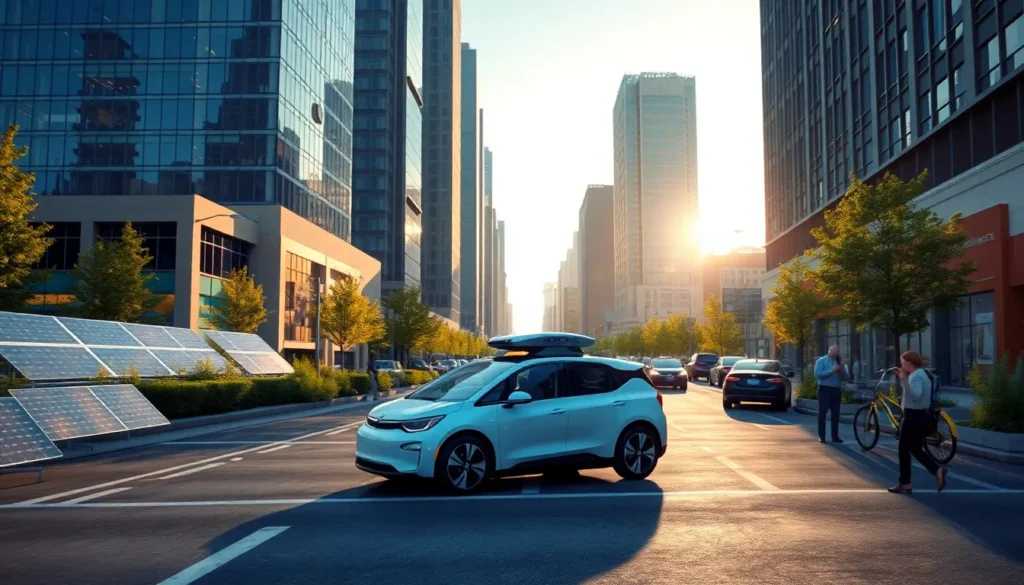
Advanced technology isn’t just a buzzword thrown around at tech conferences; it’s the magic wand transforming everyday life into something out of a sci-fi movie. From self-driving cars that make even the worst navigators feel like pros to smart fridges that remind you when you’re out of milk, advanced technology is redefining what’s possible.
Advanced Technology Definition
Advanced technology encompasses innovations that significantly enhance operations and efficiency across various sectors. Defined as tools and systems that push the boundaries of what is possible, it includes robotics, artificial intelligence, and biotechnology. Each technology represents a leap forward, offering solutions that were previously unimaginable.
Examples of advanced technology impact everyday living. Self-driving cars, for instance, allow individuals to focus on other tasks while commuting. Smart fridges optimize grocery management, alerting users when supplies dwindle and suggesting recipes based on available ingredients.
The role of advanced technology extends beyond convenience. In healthcare, AI-driven diagnostic tools improve accuracy and speed in identifying illnesses. These tools process vast amounts of data, enabling healthcare professionals to make informed decisions rapidly.
Moreover, industries adopt advanced technology to enhance production. Automation in manufacturing reduces human error and accelerates output. It increases quality control, resulting in products that meet higher standards.
Understanding advanced technology involves recognizing its contribution to sustainability as well. Green technologies, such as solar panels and electric vehicles, play essential roles in reducing carbon footprints. Their widespread adoption contributes to a more sustainable future.
Ultimately, the definition of advanced technology continuously evolves. Innovations emerge rapidly, reshaping definitions and expectations. Observing these changes provides insights into how society adapts and how technology influences daily life.
Key Characteristics of Advanced Technology

Advanced technology exhibits remarkable traits that distinguish it from traditional methods. Its primary features include a strong emphasis on innovation and seamless integration into existing systems.
Innovation and Creativity
Innovation drives advanced technology, propelling industries forward. Breakthroughs in areas such as artificial intelligence and biotechnology represent creative solutions to longstanding challenges. These advancements encourage organizations to think outside the box, fostering a culture of experimentation and progress. Creative applications often transform sectors, making processes more efficient and user-friendly. For example, AI-powered tools streamline workflows and enhance decision-making capabilities. As creativity flourishes, the potential for developing groundbreaking technologies continues to expand, reshaping everyday life.
Integration of Technology
Integration plays a crucial role in the effectiveness of advanced technology. Systems and devices seamlessly connect, creating networks that enhance functionality. For instance, smart home devices work together to optimize energy consumption and improve security. Businesses leverage integrated technologies to automate processes and reduce operational costs, leading to increased productivity. Workers benefit from tools designed to support collaboration and communication across platforms. Such integration ensures that users experience a cohesive and efficient technological landscape, driving a more interconnected future.
Examples of Advanced Technology
Advanced technology manifests in various forms, revolutionizing multiple sectors. Notable examples include artificial intelligence and renewable energy solutions.
Artificial Intelligence
Artificial intelligence, or AI, stands out for its ability to analyze data and make decisions swiftly. Applications in healthcare involve AI-driven diagnostic tools that enhance accuracy and patient outcomes. Businesses leverage AI for customer service automation, improving response times and user experience. Furthermore, AI systems optimize supply chain management by predicting demands and streamlining processes. Drones, equipped with AI, perform tasks such as aerial surveys and deliveries, illustrating its versatility across different domains.
Renewable Energy Solutions
Renewable energy solutions play a crucial role in promoting sustainability. Solar panels harness sunlight, significantly reducing reliance on fossil fuels. Wind turbines convert wind currents into electricity, providing a clean energy source that benefits the environment. Moreover, advancements in battery technology enable efficient storage of energy generated from renewable sources, ensuring availability when needed. Electric vehicles represent another innovative aspect, helping decrease carbon emissions while providing efficient transportation options. These technologies collectively contribute to a greener future and reflect a significant shift toward sustainable practices in energy consumption.
The Impact of Advanced Technology
Advanced technology reshapes contemporary society, driving both economic growth and social changes. It enhances productivity and quality of life while fostering innovation across sectors.
Economic Growth
Increased efficiency often leads to substantial economic growth. Automation streamlines processes within various industries, resulting in lower operational costs. Significant investment in advanced technology promotes job creation, especially in tech-driven fields. Reports show that automation could contribute to a projected 6.6% increase in global GDP by 2030. Moreover, small businesses thrive through access to advanced tools that boost competitiveness. Entrepreneurs can leverage big data analytics for informed decisions, optimizing resource allocation. Enhanced technological infrastructure encourages international trade, as countries adopt advanced manufacturing techniques.
Social Changes
Transformative social changes arise from the integration of advanced technology in everyday life. Communication improves through platforms that connect people globally and facilitate collaboration. Education benefits from online learning tools, making quality resources accessible to diverse populations. Health care innovations, like telemedicine, offer remote patient consultations, revolutionizing access to medical support. Furthermore, smart technologies promote sustainable living, encouraging communities to adopt energy-efficient practices. Urban areas experience revitalization as smart city technologies improve infrastructure and services, fostering safer living environments. Social responsibility increases as individuals embrace tech-enabled initiatives focusing on community engagement and environmental stewardship.
Conclusion
Advanced technology is reshaping the landscape of everyday life in profound ways. Its continuous evolution highlights the importance of innovation and integration in enhancing efficiency and convenience. As society embraces these cutting-edge solutions, the benefits extend beyond individual convenience to broader economic and social improvements.
From healthcare advancements to sustainable energy practices, the impact of advanced technology is undeniable. As innovations continue to emerge, they’ll further redefine possibilities and foster a future that prioritizes efficiency, sustainability, and improved quality of life. The journey of advanced technology is just beginning, promising exciting developments ahead.








